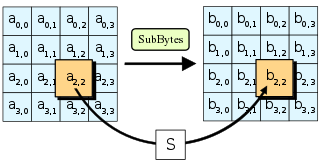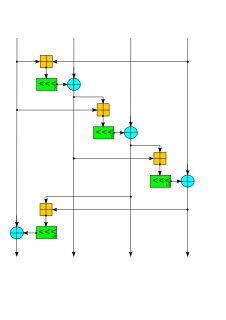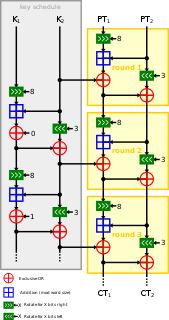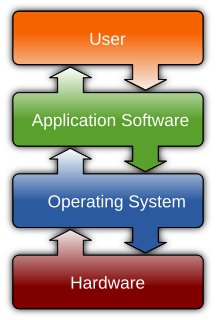
The Advanced Encryption Standard (AES), also known by its original name Rijndael, is a specification for the encryption of electronic data established by the U.S. National Institute of Standards and Technology (NIST) in 2001.
In cryptography, RC4 is a stream cipher. While it is remarkable for its simplicity and speed in software, multiple vulnerabilities have been discovered in RC4, rendering it insecure. It is especially vulnerable when the beginning of the output keystream is not discarded, or when nonrandom or related keys are used. Particularly problematic uses of RC4 have led to very insecure protocols such as WEP.
In cryptography, a block cipher mode of operation is an algorithm that uses a block cipher to provide information security such as confidentiality or authenticity. A block cipher by itself is only suitable for the secure cryptographic transformation of one fixed-length group of bits called a block. A mode of operation describes how to repeatedly apply a cipher's single-block operation to securely transform amounts of data larger than a block.
In modern cryptography, symmetric key ciphers are generally divided into stream ciphers and block ciphers. Block ciphers operate on a fixed length string of bits. The length of this bit string is the block size. Both the input (plaintext) and output (ciphertext) are the same length; the output cannot be shorter than the input – this follows logically from the pigeonhole principle and the fact that the cipher must be reversible – and it is undesirable for the output to be longer than the input.

Serpent is a symmetric key block cipher that was a finalist in the Advanced Encryption Standard (AES) contest, where it was ranked second to Rijndael. Serpent was designed by Ross Anderson, Eli Biham, and Lars Knudsen.

A cryptographic hash function (CHF) is a hash function that is suitable for use in cryptography. It is a mathematical algorithm that maps data of arbitrary size to a bit string of a fixed size and is a one-way function, that is, a function which is practically infeasible to invert. Ideally, the only way to find a message that produces a given hash is to attempt a brute-force search of possible inputs to see if they produce a match, or use a rainbow table of matched hashes. Cryptographic hash functions are a basic tool of modern cryptography.
Phelix is a high-speed stream cipher with a built-in single-pass message authentication code (MAC) functionality, submitted in 2004 to the eSTREAM contest by Doug Whiting, Bruce Schneier, Stefan Lucks, and Frédéric Muller. The cipher uses only the operations of addition modulo 232, exclusive or, and rotation by a fixed number of bits. Phelix uses a 256-bit key and a 128-bit nonce, claiming a design strength of 128 bits. Concerns have been raised over the ability to recover the secret key if the cipher is used incorrectly.
In cryptography, FROG is a block cipher authored by Georgoudis, Leroux and Chaves. The algorithm can work with any block size between 8 and 128 bytes, and supports key sizes between 5 and 125 bytes. The algorithm consists of 8 rounds and has a very complicated key schedule.
In cryptography, MUGI is a pseudorandom number generator (PRNG) designed for use as a stream cipher. It was among the cryptographic techniques recommended for Japanese government use by CRYPTREC in 2003, however, has been dropped to "candidate" by CRYPTREC revision in 2013.
Poly1305 is a cryptographic message authentication code (MAC) created by Daniel J. Bernstein. It can be used to verify the data integrity and the authenticity of a message. A variant of Bernstein's Poly1305 that does not require AES has been standardized by the Internet Engineering Task Force in RFC 8439.

VEST ciphers are a set of families of general-purpose hardware-dedicated ciphers that support single pass authenticated encryption and can operate as collision-resistant hash functions designed by Sean O'Neil, Benjamin Gittins and Howard Landman. VEST cannot be implemented efficiently in software.

Salsa20 and the closely related ChaCha are stream ciphers developed by Daniel J. Bernstein. Because the two ciphers are very similar, this article will occasionally discuss them together. Salsa20, the original cipher, was designed in 2005, then later submitted to eSTREAM by Daniel J. Bernstein. ChaCha is a modification of Salsa20 published by Bernstein in 2008. It uses a new round function that increases diffusion and increases performance on some architectures.
Py is a stream cipher submitted to eSTREAM by Eli Biham and Jennifer Seberry. It is one of the fastest eSTREAM candidates at around 2.6 cycles per byte on some platforms. It has a structure a little like RC4, but adds an array of 260 32-bit words which are indexed using a permutation of bytes, and produces 64 bits in each round.
The Scream cipher is a word-based stream cipher developed by Shai Halevi, Don Coppersmith and Charanjit Jutla from IBM.
The Hasty Pudding Cipher (HPC) is a variable-block-size block cipher designed by Richard Schroeppel, which was an unsuccessful candidate in the competition for selecting the U.S. Advanced Encryption Standard (AES). It has a number of unusual properties for a block cipher: its input block size and key length are variable, and it includes an additional input parameter called the "spice" for use as a secondary, non-secret key. The Hasty Pudding cipher was the only AES candidate designed exclusively by U.S. cryptographers.
In cryptography, a T-function is a bijective mapping that updates every bit of the state in a way that can be described as , or in simple words an update function in which each bit of the state is updated by a linear combination of the same bit and a function of a subset of its less significant bits. If every single less significant bit is included in the update of every bit in the state, such a T-function is called triangular. Thanks to their bijectivity regardless of the used Boolean functions and regardless of the selection of inputs, T-functions are now widely used in cryptography to construct block ciphers, stream ciphers, PRNGs and hash functions. T-functions were first proposed in 2002 by A. Klimov and A. Shamir in their paper "A New Class of Invertible Mappings". Ciphers such as TSC-1, TSC-3, TSC-4, ABC, Mir-1 and VEST are built with different types of T-functions.
JH is a cryptographic hash function submitted to the NIST hash function competition by Hongjun Wu. Though chosen as one of the five finalists of the competition, JH ultimately lost to NIST hash candidate Keccak. JH has a 1024-bit state, and works on 512-bit input blocks. Processing an input block consists of three steps:
- XOR the input block into the left half of the state.
- Apply a 42-round unkeyed permutation (encryption function) to the state. This consists of 42 repetitions of:
- Break the input into 256 4-bit blocks, and map each through one of two 4-bit S-boxes, the choice being made by a 256-bit round-dependent key schedule. Equivalently, combine each input block with a key bit, and map the result through a 5→4 bit S-box.
- Mix adjacent 4-bit blocks using a maximum distance separable code over GF(24).
- Permute 4-bit blocks so that they will be adjacent to different blocks in following rounds.
- XOR the input block into the right half of the state.

Speck is a family of lightweight block ciphers publicly released by the National Security Agency (NSA) in June 2013. Speck has been optimized for performance in software implementations, while its sister algorithm, Simon, has been optimized for hardware implementations. Speck is an add–rotate–xor (ARX) cipher.








